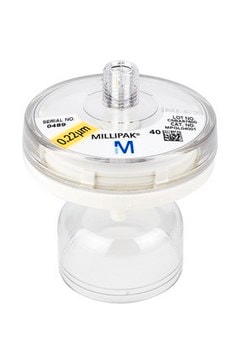MFGL04GF3
Durapore® 0.22 µm, Millipak® Final Fill Capsule
non-sterile (non-sterilized), Millipak® Final Fill 40, pore size 0.22 μm
Synonym(s):
Millipak® Final Fill 40
About This Item
Recommended Products
material
PVDF membrane
polysulfone device
polysulfone support
Quality Level
Agency
certified by the ISO 9001:2015 (Quality Management Systems)
meets requirements for EP 2.6.14
meets requirements for JP 4.01
meets requirements for USP 85
sterility
irradiated
non-sterile (non-sterilized)
Sterilization Compatibility
gamma compatible
product line
Millipak® Final Fill 40
feature
hydrophilic
packaging
bag of 3 × double easy-open bag
parameter
1.0 L/min flow rate at 0.69 bar
10 psi max. differential pressure (0.7 bar) at 25 °C (Reverse)
25 psi max. differential pressure (1.7 bar) at 25 °C (Forward)
50 psi max. differential pressure (3.5 bar) at 25 °C (Forward)
60 psi max. differential pressure (4.1 bar) at 25 °C (Forward)
60 psi max. inlet pressure (4.1 bar) at 25 °C
80 psi max. differential pressure (5.5 bar) at 25 °C (Forward)
80 psi max. inlet pressure (5.5 bar) at 25 °C
technique(s)
sterile filtration: suitable
L
3.4 in.
W
3.0 in.
filtration area
200 cm2
impurities
<0.25 EU/mL bacterial endotoxins (LAL test)
matrix
Durapore®
pore size
0.22 μm pore size
bubble point
≥50 psi (3450 mbar), air with water at 23 °C
fitting
3/4 in. inlet connection
19 mm (3/4 in.) inlet/outlet connection (sanitary flange)
(19 mm (3/4 in.) Sanitary Flange Inlet and Outlet)
General description
Packaging
Preparation Note
Device integrity and retention was maintained after 3 autoclave cycles of 90 minutes at 126 <nbsp/>°C. Devices can withstand a dose ? 40<nbsp/> kGy gamma exposure.
Analysis Note
Other Notes
Legal Information
What is the Emprove® Program?
The Emprove® Program is a system providing comprehensive and thorough documentation of our filters and single-use components, pharma raw materials, and starting materials. Four document types are included with an Emprove® Program subscription:
Free of charge - Sign in to download
Free of charge - Sign in to download
Free of charge - Sign in to download
Available by subscription or for a fee
Available by subscription or for a fee
Already Own This Product?
Find documentation for the products that you have recently purchased in the Document Library.
Related Content
This page summarizes key considerations related to regulatory expectations for biomanufacturing including chemicals and polymeric materials. For chemicals, topics include nitrosamines and elemental impurities, and for polymeric materials such as filters and single-use assemblies, the focus is qualification and extractable and leachable testing.
This page summarizes key considerations related to regulatory expectations for biomanufacturing including chemicals and polymeric materials. For chemicals, topics include nitrosamines and elemental impurities, and for polymeric materials such as filters and single-use assemblies, the focus is qualification and extractable and leachable testing.
This page summarizes key considerations related to regulatory expectations for biomanufacturing including chemicals and polymeric materials. For chemicals, topics include nitrosamines and elemental impurities, and for polymeric materials such as filters and single-use assemblies, the focus is qualification and extractable and leachable testing.
This page summarizes key considerations related to regulatory expectations for biomanufacturing including chemicals and polymeric materials. For chemicals, topics include nitrosamines and elemental impurities, and for polymeric materials such as filters and single-use assemblies, the focus is qualification and extractable and leachable testing.
Active Filters
Our team of scientists has experience in all areas of research including Life Science, Material Science, Chemical Synthesis, Chromatography, Analytical and many others.
Contact Technical Service





